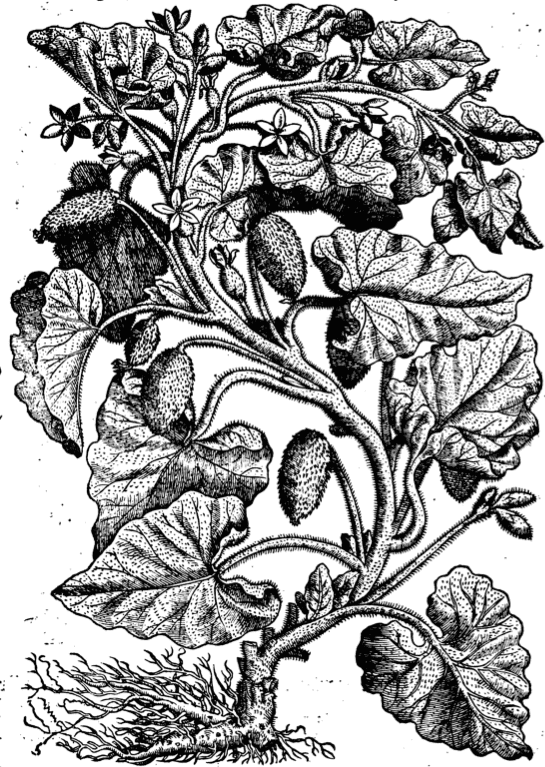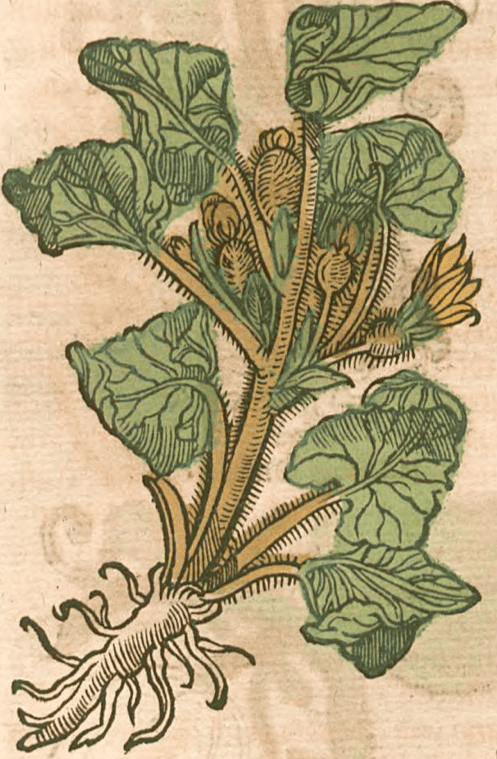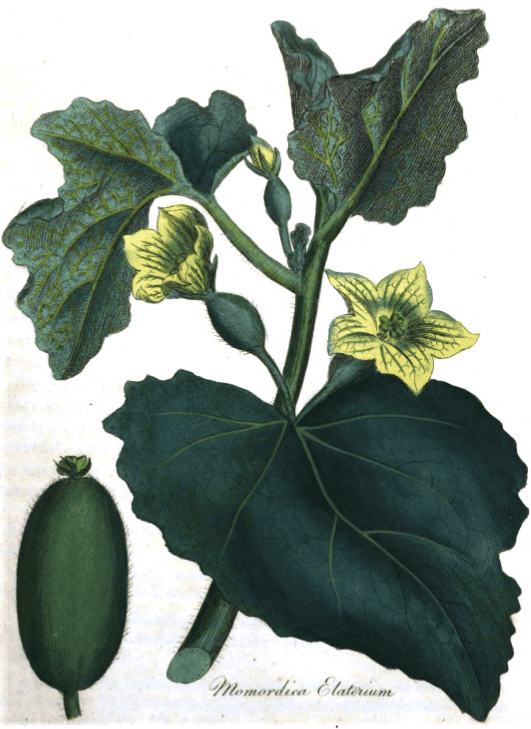Elaterium, Wild CucumberSquirting Cucumber; Cucumer asininus, Cucumis erraticusKantaki Indravaaruni (Ayurveda) |

|

|

|

|
|
New Kreuterbuch, Matthiolus, 1563 |
Krauterbuch, Lonitzer, 1578 |
 Medical Botany, Woodville, 1810
Medical Botany, Woodville, 1810Botanical name:
Ecballium elaterium
(synonyms include Ecballium officinale, Ecballium agreste, Momordica Elaterium, Elaterium cordifolium, Cucumis agrestis. [Pharmacopoeia Londinensis], Cucumis asininus. Cucumis sylvestris)
Parts used:
Concentrated fruit juice, Elaterium
Two varieties are known: a white and a black. The first is obtained from juice that issues spontaneously, the latter from juice obtained by expression and evaporated.
Temperature & Taste:
Hot, dry. Bitter, Pungent. Toxic
Classifications:
2F. PURIFYING 2L. EMOLLIENT 2U. SUPPURATIVES
Uses:
1. Purges Bile, Phlegm and Water:
-stubborn Edema in strong bodies; Ascites, Pulmonary Edema
-obstructions with excess (in strong bodies)
-asthma
-Scrofula, Struma
-Leukorrhea
-Jaundice
2. Clears Damp, Promotes Urine:
-Eclectic Physicians found small doses useful in Chronic cystitis with “constant, more or less painful sensation in the region of the neck of the bladder, where the urine passes in a torrent as if poured through the urethra, and where, after micturition, there is a violent, cramp-like aching in the parts, often extending over the whole lower pelvic region and thighs”. (King)
3. Forcefully Promotes Menstruation:
Formerly to promote Menstruation, expel the afterbirth, and to cause abortion.
-should no longer be used for this purpose
4. Externally:
-Oil was used for Tumors, Scrofula, Struma and hard phlegmatic swellings.
Dose:
Only suitable for strong bodies and short-term use. In Edema, the best way is to give small doses more frequently, ¼ to ½ grain, every 1–2 hours until it operates. Always used with milder purgatives such as Aloe or Rhubarb, where it will act to accentuate the effect.
Elaterium: half–3 grains; Extract of the dried juice (made with Brandy) 2–4 grains
Eclectic Physicians gave small doses for Chronic Cystitis: 1/20 to ⅛ grain.
Preparing Elaterium:
1. The London Pharmacopoeia gave the following method of preparation: “Slit ripe wild cucumbers, and pass the juice (very lightly pressed) through a very fine sieve into a glass vessel; then set it by for some hours, until the thicker part has subsided. Pour off the thinner part swimming at the top, and separate the rest by filtering; cover the thicker part which remains after filtration, with a linen cloth, and dry it with a gentle heat.”
2. Salmon said the best way was to take the freshly pressed juice of Wild Cucumber, clarify it (which may be done by leaving it to settle, removing the scum and the dregs); then put it into a glased earthen pot and over a gentle heat, evaporate to the consistency of an extract. Salmon claimed this was a better preparation then the use of acids (as with the Extract of Le Febur, given below).
3. See other preparations below.
Comment:
Elaterium was long known to be the longest lasting of any dehydrated juice, some claiming it is still effective after 100 years. It was best when between 2 and 10 years old. The best is white, light and burns like fat.
Main Combinations:
1. To purge Phlegm and Bile:
i. Wild Cucumber with Aloe, Agaric and Centaury
ii. Wild Cucumber with Rhubarb, Aloe, Agaric, Orris, Centaury, Rock Salt, Ginger, Cinnamon, Aniseed
Major Formulas:
Pills of Opopanax (De morbus internis curandis)
Pills to Purge Bile and Phlegm (2) (Mesue)
Cautions:
1. Highly irritant and toxic due to the cucurbitacins. It has been called the most violent purgative of the Materia Medica and should only be used in strong bodies where milder purgatives have failed. Full doses can cause vomiting, colic and severe diarrhea.
2. Not used in Pregnancy, the very young, elderly or weak.
3. Not used in Yin deficiency.
Main Preparations used:
Extract of the dried juice made with Spirit of Wine (Brandy)
Other Preparations of Elaterium
Le Febur’s Extract of Elaterium:
Dried Elaterium 1 oz.
Salt of Tartar 2 drams
Grind them together, Put in a still and cover with tartarised S.V. (Brandy with salt of tartar added). Digest in a gentle warmth (water bath) for 20 days, shaking the glass daily. Decant the clear tincture and add expressed oil of Nutmeg half dram, and Magistery of Coral 1 dram; mix well, then abstract (evaporate) the Spirit in B.M. (water bath) to the consistency of an extract suitable for pills.
This preparation was said to correct the harshness of the drug while allowing it to remain effective for the intended purposes. Used to purge Phlegm, Damp and Water from the Joints, Bowels and Uterus, given for Edema, Arthritic pain, Sciatica, Atrophy etc.
Dose: 2–12 grains (Salmon, Seplasium)
A Tincture of Elaterium from Kings American Dispensatory, 1898:
Morris recommends a tincture of elaterin made by dissolving 1 grain in 1 fluid ounce of alcohol, to which 4 drops of nitric acid have been added; the dose is from 20 to 40 drops diluted with cinnamon water.
-
Extra Info
-
History
|
‘Under the name of Kateri-indrayan, the fruit of this plant, or of a closely allied species, is sold in the Bombay shops. It is imported from Persia, and has evidently been gathered while immature, as the contents of the cucumber have not been discharged. Elaterium does not appear to be known in Hindu medicine, but the Arabs and Persians are well acquainted with it. The former call the fruit Katha-ul-himar and the latter Khiyar-i-khar (Asses’ cucumber). The author of the Makhzan-el-Adwiya describes it, and also the method of preparing Elaterium. To prepare this he directs the fruit to be sliced, thrown upon a strainer and pressed, the pulp is then to be twice washed with water, and the deposit, which is |
thrown down from the water,collected and dried. It is then to be finely powdered and made into lozenges, with an equal weight of gum Arabic or Calamine, or half its weight of starch. The Mahometan writers attach considerable importance to Elaterium as a purgative of the diseased humours, which they suppose to be the cause of a great number of diseases. They also use poultices made with the fruit, leaves and root of the plant, and direct the juice of the fruit to be snuffed up the nose to purge the brain and to be dropped into the ears in otitis. It is worthy of remark that the Hindus use their bitter and purgative cucurbitaceous fruits in the same manner. (Vegetable Materia Medica of Western India, Dymock, 1885) |
